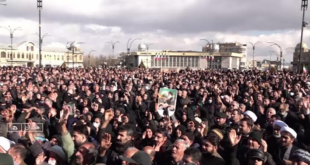Dystopian displays of technological prowess serve to distract the Israeli public from the military’s failure to achieve its long-stated war aims.
After detonating thousands of pagers carried by Hezbollah members in an attack that caught much of the world by surprise, Israel has now launched a bloody aerial and ground assault on Lebanon. Since Sept. 23, Israeli airstrikes have killed more than 1,000 people, including hundreds of women and children, in what has been described as one of the most intense air raids in modern history. Over one million are displaced across the country. And despite assassinating Hezbollah leader Hassan Nasrallah, Israel’s aggression shows no sign of slowing down.
The Hamas-led October 7 attack dealt a resounding blow to Israel’s image as the Middle East’s ultimate security state, as has a year of protracted guerilla warfare in Gaza. Now, more fighting in Lebanon offers the opportunity for image restoration. As in Gaza, death and destruction abetted by sophisticated espionage networks and algorithmic weapons systems are critical to this makeover. Indeed, the Israeli and international press hailed the pager attacks and assassination of Nasrallah as proof of the army’s technological prowess.
Yet Israel will not bring about regional security, or even its own, through displays of technological supremacy. Theatrical Mossad operations, algorithmically-determined airstrikes, and AI-assisted fighting forces may paint an alluring picture, but behind the scenes is a battered military waging a war with no end strategy. For those in charge — politicians eager to stay in power and generals intent on annexation — that is precisely the point. Endless war keeps political solutions at bay, while security is subordinated to expansion and domination.
Iran’s unprecedented ballistic missile attack on Tuesday night was further proof that this spiral of insecurity will continue. Israel’s missile defense systems, with the help of the United States, Jordan, and possibly other regional allies, succeeded in shooting down the majority of the projectiles and preventing casualties (save for a Palestinian in Jericho who was killed by falling shrapnel), and now the Israeli army appears poised to meet the attack with even more force.
Deep fragmentation, and eroding trust
The Israeli military’s claims of technological prowess have long distracted from its ineffective policies across the occupied Palestinian territories and the increasing dysfunction within its ranks. Even as the military has advertised itself as a sophisticated AI superpower, the growing number of openly far-right troops who defy the army’s official rules of engagement — often with their commanders’ acquiescence — threatens to send the military into disarray.
Troops are egged on by religious fundamentalists like Brigadier General Barak Hiram, who has called on Israelis to reclaim “ancient values,” as well as messianic politicians eager to annex the West Bank and Gaza. Shooting to kill protestors in the West Bank, indiscriminate bombing across Gaza, bulldozing civilian infrastructure throughout the occupied territories, and torturing Palestinian prisoners — such practices have become the norm.
Yagil Levy, head of the Open University’s Institute for the Study of Civil-Military Relations, has been tracking these shifts for years. “We see the obstruction of the military hierarchy, the undermining of military discipline, and disputes over core values,” Levy told +972. “There is fragmentation deep within the military.”
The last year of fighting in Gaza has laid these systemic woes bare. In January, reservists and acting soldiers protested the partial withdrawal from Gaza, railing against Prime Minister Benjamin Netanyahu for not reoccupying the Strip. In July, 1,200 far-right activists — many acting reservists among them — stormed the Beit Lid military base to protest the detention of soldiers accused of raping Palestinian prisoners. Earlier this month, the 769th Brigade rebelled against upper command by dropping evacuation notices in communities in southern Lebanon in the hope of launching a full-fledged attack.
Coming after a year of intelligence failures, strategic blunders in Gaza, and an inability to rescue the remaining hostages, these scandals have only eroded the army’s reputation in Israel. Polls over the summer showed that Israelis’ trust in the military has plummeted, and concerns over the country’s security are at an all-time high.
Now, amid these internal divisions and well-documented recruitment woes, expanding the war in Lebanon offers the army an opportunity to restore its lost prestige. “This is the military that the Israeli public admires,” Levy said of the pager attack — a technologically unprecedented operation, which took several years for the Mossad and military intelligence to orchestrate.
If abroad, the apocalyptic scenes in Lebanon have fueled allegations of Israeli war crimes, in Israel, the bloodshed has been met with celebrations: dancing in the streets of Tel Aviv, congratulatory memes across social media, and declarations of victory on cable TV. “It’s far away from the military that failed on October 7 and that is fighting an endless war in Gaza,” Levy said of the army’s offensive in Lebanon and how it is being depicted.
As in the first months of the war in Gaza, today’s displays of force distract the Israeli public from asking if more violence coheres with the stated aim of war in Lebanon: returning residents of northern Israel to their homes. Few public figures have questioned whether the catastrophic civilian death toll and now a ground invasion will actually enhance Israeli security in the long term. As Levy put it, “there is no clear linkage between this show of capacity and achieving Israel’s political goals.”
‘It’s as if we’re living in some sort of dystopia’
If the military’s celebration of its AI-assisted weapons systems and cutting-edge surveillance capabilities serves to distract from its own internal discord, so too has it disguised the Gaza war’s political goals: entrenching Benjamin Netanyahu’s power and furthering the expansionist aims of his right-wing coalition, who see endless violence as the only way to achieve sovereignty over “Greater Israel.”
War in Lebanon has only fueled support for the current government, with Netanyahu’s Likud party winning a clear majority among voters in a recent poll by Channel 12. Although tens of thousands of protestors took to the streets of Tel Aviv this spring and summer demanding the prime minister’s resignation as the war in Gaza dragged on, aggression in the north has been met with widespread support. Yair Golan, head of the new Zionist-left merger of the Labor Party and Meretz and a vocal critic of Israeli strategy in Gaza, has outflanked many on the right in calling for the occupation of southern Lebanon.
Yet those tracking the destruction in Lebanon say the army is deploying the same tactics and technologies that it has used in Gaza over the past year. “In Gaza, we’ve seen the military kill tens or hundreds to get one high-level operator,” Heiko Wimmen, who oversees International Crisis Group’s Iraq/Syria/Lebanon project, told +972. “[Now,] we’re seeing that style of warfare come to Lebanon.”
Israeli military heads have promised as much in recent years. After the army waged what it called “the first AI war” against Hamas in Gaza in 2021, members of the security establishment boasted of nearly identical targeting systems in place across the northern border. “Soon, the algorithms used in Gaza will echo in Beirut,” unnamed officials told Ynet after the 11-day war ended in May 2021.
Today, Israeli spy satellites, AI-assisted drones, CCTV cameras, GPS monitoring, and cyberespionage systems provide intelligence on Lebanon, and algorithms cull through this data to churn out recommended targets. As they did after declaring war in Gaza, intelligence heads are now boasting of a sophisticated surveillance apparatus informing the army’s so-called “targeted” airstrikes across Lebanon. But like in Gaza, Israel has used its technological prowess to exact a devastating toll on civilian life, rather than limit the number of noncombatants killed.
Indeed, social media has been awash with videos of bombs obliterating homes, cratering residential streets, blocking ambulances, and filling roads with rubble across Lebanon. “Footage of these attacks indicates that [the airstrikes] are not all clearly against specific persons,” Wimmen said. “They explode in between buildings or blow up buildings that are liable to create collateral damage.”
“It’s as if we’re living in some sort of dystopia,” Karim Emile Beitar, associate research fellow at the Institute for International and Strategic Affairs in Paris (IRIS), who is based between Beirut and Paris, told +972 of the violence seen in the past two weeks. “What has been called precision strikes appear to be indiscriminate attacks, targeting women, children, the elderly, ambulances, schools, churches, and hospitals.”
More death may be the point for an army that seems intent on ramping up regional war. For months now, Israel’s defense establishment has brandished body counts, rather than real operational gains, as the main metric of military efficacy. No matter that the bloodbath has failed to return Israeli civilians to their homes in the country’s north and south or bring back the hostages held captive in Gaza — who, with the opening of a new military front, have been effectively abandoned.
‘Every Israeli invasion of Lebanon was counterproductive’
As the Israeli army pushes ahead with a ground invasion of southern Lebanon, it remains to be seen how successful this latest attempt to restore its image will be. Ex-military officials continue to warn of the divisions and dysfunction plaguing Israel’s combat forces — who, as history teaches, risk suffering many more casualties in an invasion of their northern neighbor. “The IDF failed to destroy Hamas,” Major General Itzhak Brik, the ex-ombudsman for the army, wrote in an op-ed on the morning of the pager attack. “It certainly won’t be able to destroy Hezbollah, which is hundreds of times more powerful.”
Israel’s invasions of Lebanon in 1982 and 2006 caused exorbitant civilian casualties but failed to decimate Hezbollah and other Palestinian militias. On the contrary, Hezbollah was established to resist the Israeli invasion of 1982, and Israel’s 34-day war across southern Lebanon in 2006 only consolidated the militant group’s power.
“Every single Israeli invasion of Lebanon ended up being extraordinarily counterproductive for Israel,” Beitar, of IRIS, explained. “Israel has an overwhelming technological superiority, but if it launches a ground invasion, it is likely to face significant resistance,” he said last week.
Ceasefire proposals have offered provisions to achieve Israel’s stated war aims: freeing the hostages and returning those displaced by the fighting to their homes. But Netanyahu and his allies have long declared that Israel can only “live by the sword,” which is why he has consistently torpedoed diplomatic solutions to regional conflagration and leaned into an escalating conflict with Iran.
Despite a year of intelligence breaches and military failures, displays of technological dominance continue to convince many in Israel that this belligerence is sustainable. Without mass protests against a failed strategy at home and as diplomatic pressure from abroad remains weak at best, the escalating bloodshed appears set to continue. That, at least, is what those in power are hoping for.
 Eurasia Press & News
Eurasia Press & News




